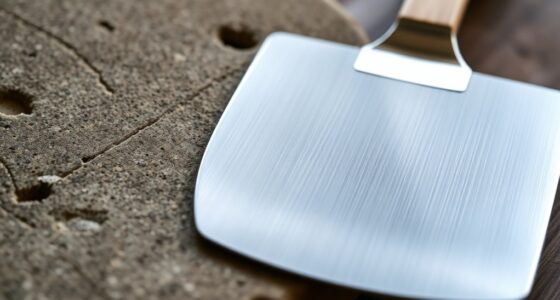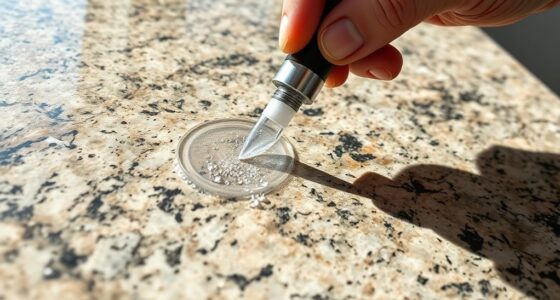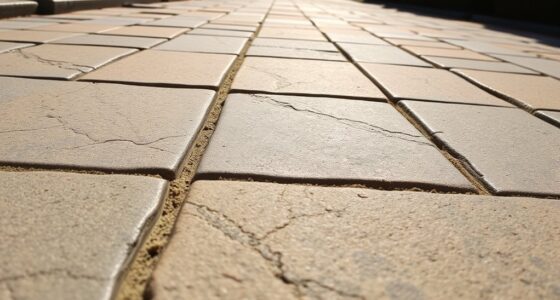Choosing between stone and steel for pizza depends on your priorities. Stones offer even baking and great heat retention but take longer to preheat and can crack if not handled carefully. Steel heats faster, conducts heat evenly, and produces crispier crusts quickly, though it’s usually pricier. Both require proper preheating and maintenance. Keep exploring to discover which surface suits your style best and how to optimize your pizza results!
Key Takeaways
- Steel heats faster and produces crisper crusts, while stones offer more even baking with slower heat transfer.
- Steel surfaces are more durable, easier to clean, and resistant to cracking, making them a long-term investment.
- Stones require longer preheating and are prone to cracking, but provide steady heat retention for consistent results.
- Steel is generally more expensive upfront but offers quicker baking and easier maintenance over time.
- Choice depends on oven size, baking speed preference, crust texture, and maintenance willingness.
Understanding the Materials: What Are Stones and Steels Made Of?
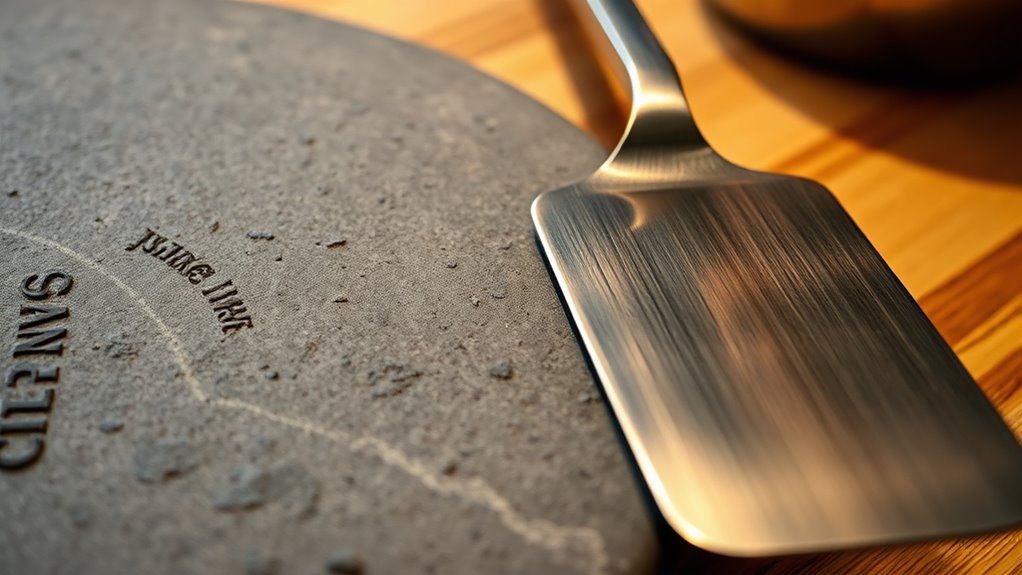
To understand the differences between stones and steels for pizza, it’s important to know what these materials are made of. Material composition directly influences their performance in baking. Stones are typically made from natural materials like cordierite or ceramic, created through firing processes that strengthen their structure. These manufacturing processes involve heating raw clay or mineral blends at high temperatures to produce a porous, heat-retentive surface. Steels, on the other hand, are crafted from various steel alloys, such as carbon or high-grade steels, shaped through forging or rolling. Their manufacturing processes involve melting and shaping the metal, resulting in a dense, durable surface. Knowing these differences helps you understand how each material’s composition and production impact their baking qualities and overall performance in pizza making. Additionally, the thermal properties of stones and steels significantly affect how heat is transferred during baking, influencing crust texture and cooking times.
Heat Retention and Conductivity: How Do They Influence Pizza Baking?
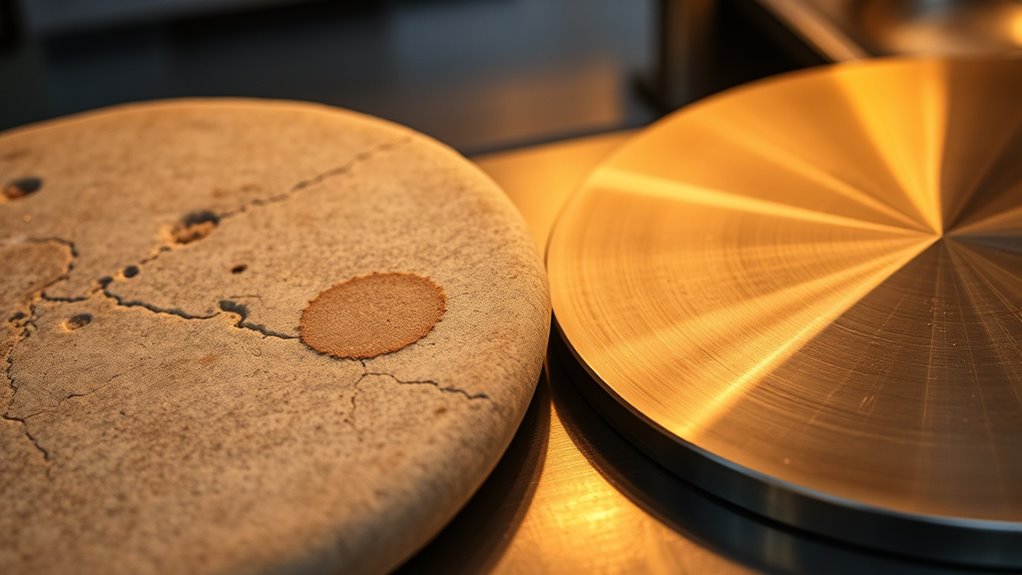
The material composition of stones and steels directly impacts how they retain and conduct heat during baking. Stones have a high thermal mass, allowing them to absorb and hold heat effectively, which leads to steady heat transfer to your pizza crust. They heat slowly but maintain consistent warmth, resulting in even cooking and a crispy bottom. Steels, on the other hand, excel at rapid heat transfer due to their excellent thermal conductivity. This means they heat up quickly and transfer heat efficiently to the dough, producing a well-baked crust in less time. Your choice affects how long the surface retains heat and how evenly it distributes it during baking. Additionally, the thermal properties of each material influence how long the surface retains heat and how evenly it distributes it during baking, ultimately impacting your pizza’s quality. Understanding these differences helps you select the right material for ideal heat retention and conductivity, ultimately influencing the quality of your pizza.
Preheating Requirements: Getting Your Surface Ready for the Perfect Pie
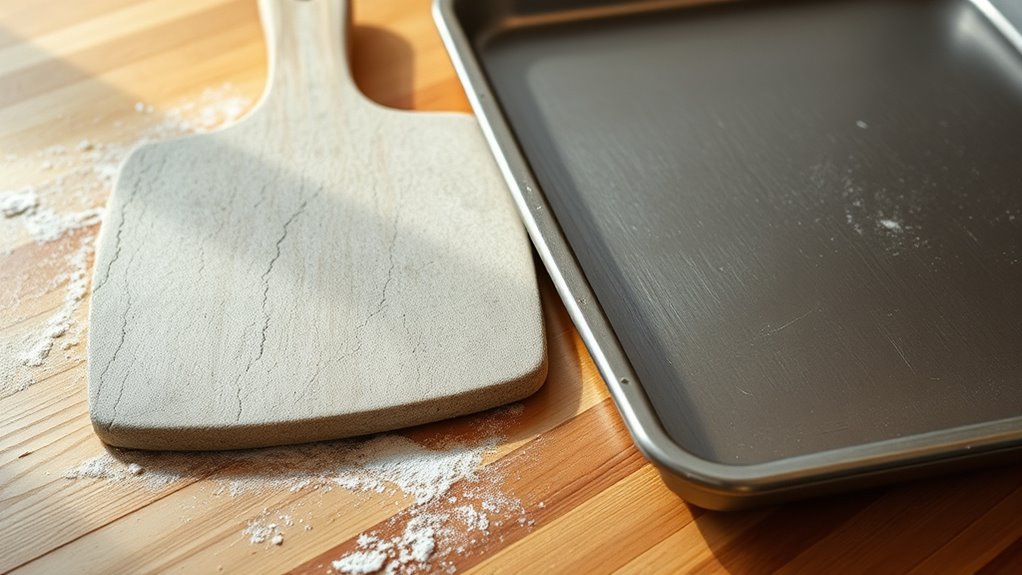
Preheating your pizza surface thoroughly is essential for achieving a perfectly baked crust. A properly heated surface ensures even heat transfer, which influences oven temperature and crust texture. To maximize preheating:
- Set your oven to a high temperature, typically between 500°F and 550°F, for both stone and steel.
- Allow sufficient preheat time—at least 45 minutes—to reach the desired oven temperature.
- Consider surface thickness; thicker surfaces require longer to reach ideal heat evenly.
- Use an infrared thermometer to verify surface temperature before baking, ensuring consistent results.
- Understanding the impact of surface material on heat retention can help you select the best option for your baking needs.
Cooking Speed and Efficiency: Which Surface Bakes Faster?
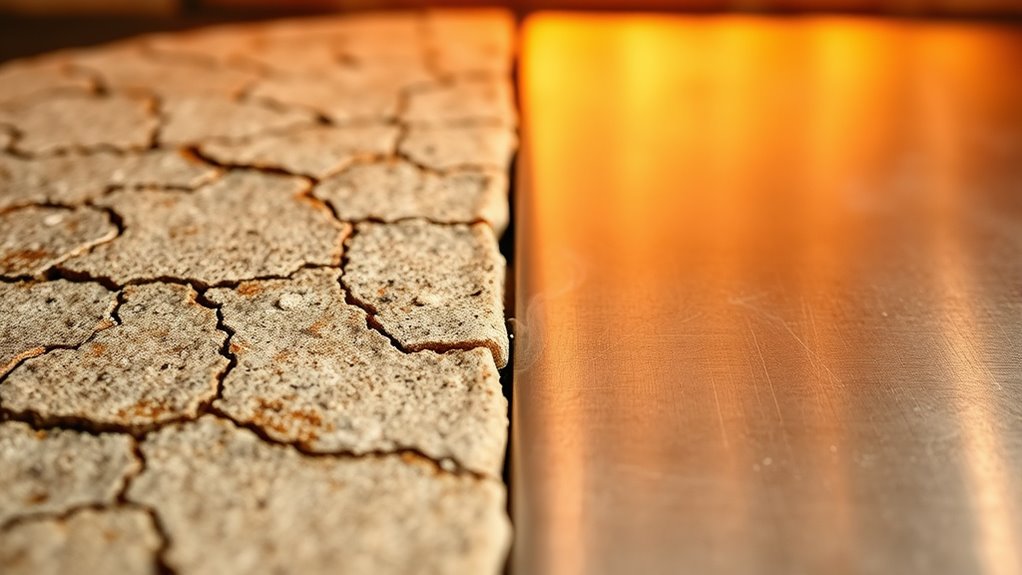
While both stone and steel surfaces can produce excellent pizzas, steel typically bakes faster due to its superior heat conduction. It heats up quickly and transfers heat efficiently, reducing baking time. This means you can crank up the oven temperature slightly higher with steel for quicker results. Conversely, stones require longer preheating and tend to bake more evenly, but at a slower pace. Additionally, cleaning ease differs: steel surfaces are easier to wipe down after baking, while stones may absorb oils and require more effort. Here’s a quick comparison: thermal properties
| Feature | Steel | Stone |
|---|---|---|
| Baking Speed | Faster | Slower |
| Oven Temperature | Higher possible | Lower, more gradual |
| Cleaning Ease | Easier | More difficult |
| Heat Conduction | Superior | Good but slower |
| Preheat Time | Shorter | Longer |
Durability and Maintenance: Longevity and Care for Stones and Steels
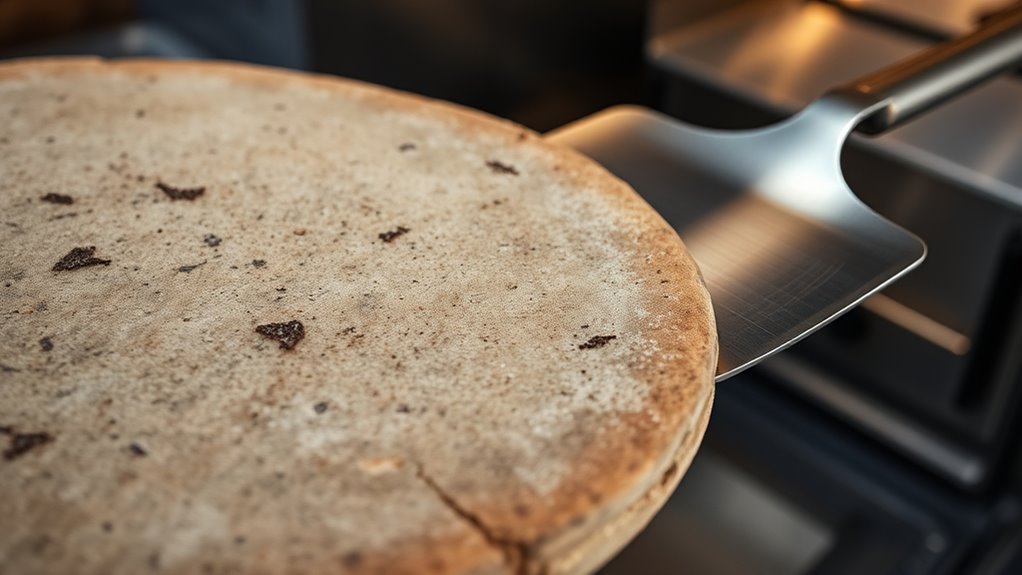
Steel surfaces generally stand up better over time due to their durability and resistance to cracking or breaking. They often require less frequent repairs and handle high temperatures without warping. To guarantee ideal surface longevity, proper cleaning maintenance is key. Here are four tips to keep your pizza surface in top shape:
- Regularly scrape off food debris to prevent buildup.
- Use gentle cleaning methods; avoid harsh chemicals that can damage the surface.
- Season steel surfaces occasionally to enhance their non-stick qualities and prevent rust.
- Store your steel pizza surface in a dry place to avoid moisture-related issues.
- Regularly review and adjust your maintenance routine to adapt to wear and tear and ensure long-term performance.
Ease of Use and Handling: Practical Considerations for Home Cooks
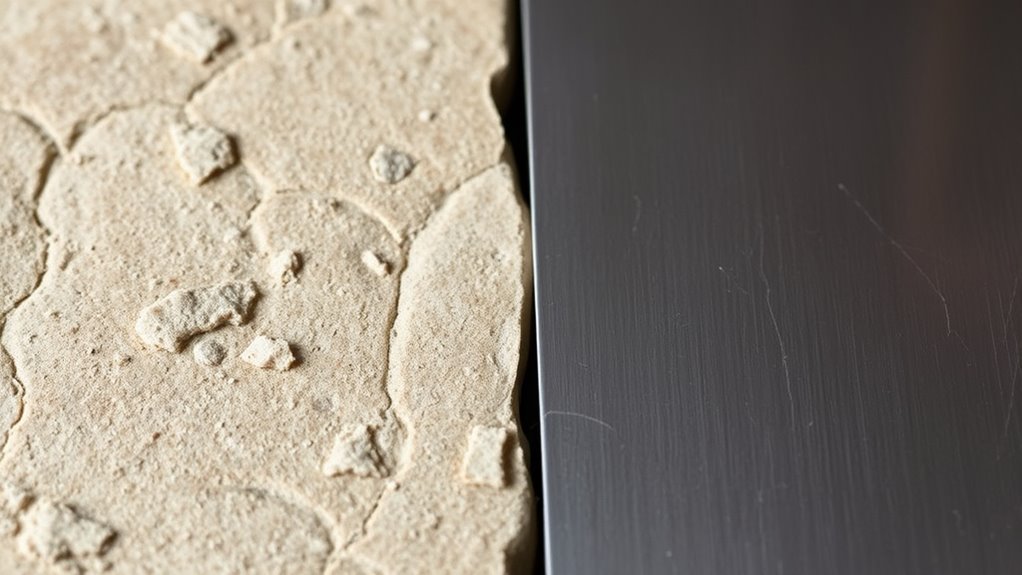
Choosing between stone and steel for your pizza surface largely depends on how easy they are to handle and use during cooking. Handling comfort plays a big role—steel is lightweight and easy to lift, making it simple to maneuver. Stones can be heavier and might require more effort when handling or repositioning. When it comes to ease of cleaning, steel surfaces usually wipe down quickly with minimal effort, while stones may need careful brushing or scraping to remove residue without damaging their porous surface. Consider your comfort level with lifting and cleaning tasks. Steel offers a smoother, more manageable experience for everyday use, while stones might demand a bit more effort but provide excellent heat retention. Your choice hinges on balancing handling ease and maintenance convenience. Additionally, understanding repair fundamentals can help you maintain your pizza surface, ensuring it remains in good condition for years to come.
Impact on Pizza Quality: Texture, Crust, and Overall Results
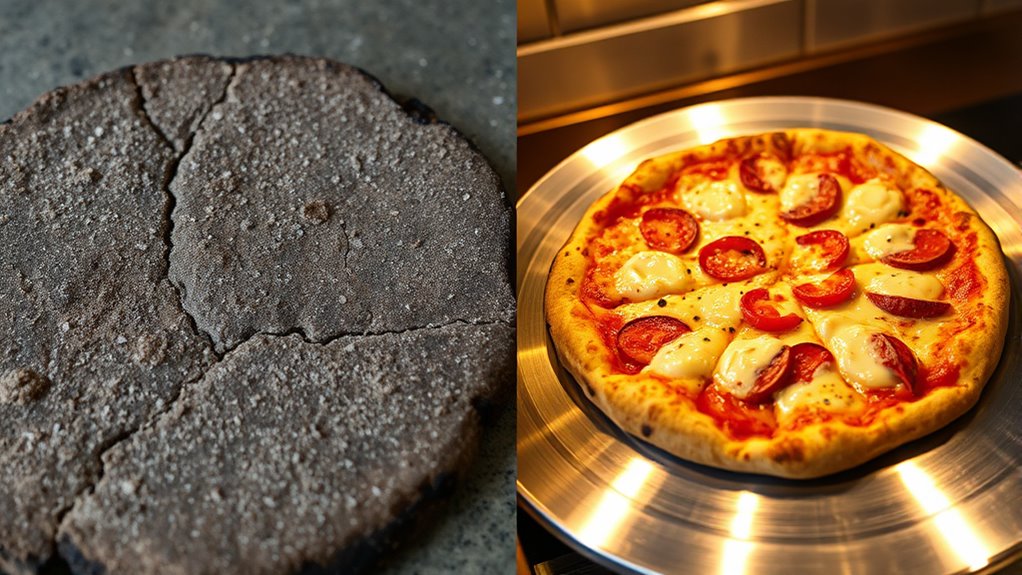
The material of your pizza surface directly influences the texture, crust, and overall quality of your finished pie. A stone heats evenly, creating a crispy crust and a well-cooked pizza dough with excellent cheese melt. Steel heats faster, providing a higher temperature that results in a more charred, yet tender crust.
Consider these key effects:
Understanding these key effects can help you choose the perfect surface for your pizza perfection.
- Crust Texture: Stone yields a softer, airy crust, while steel produces a crunchier exterior.
- Pizza Dough: Steel’s rapid heat creates a more developed rise, enhancing overall dough structure.
- Cheese Melt: Both materials promote even heat, but steel’s quick heat transfer can lead to faster, more uniform cheese melt.
- Overall Results: Steel often delivers a more consistent, restaurant-quality pizza, while stone offers a traditional, artisanal feel.
Cost and Investment: Budgeting for Your Pizza Setup
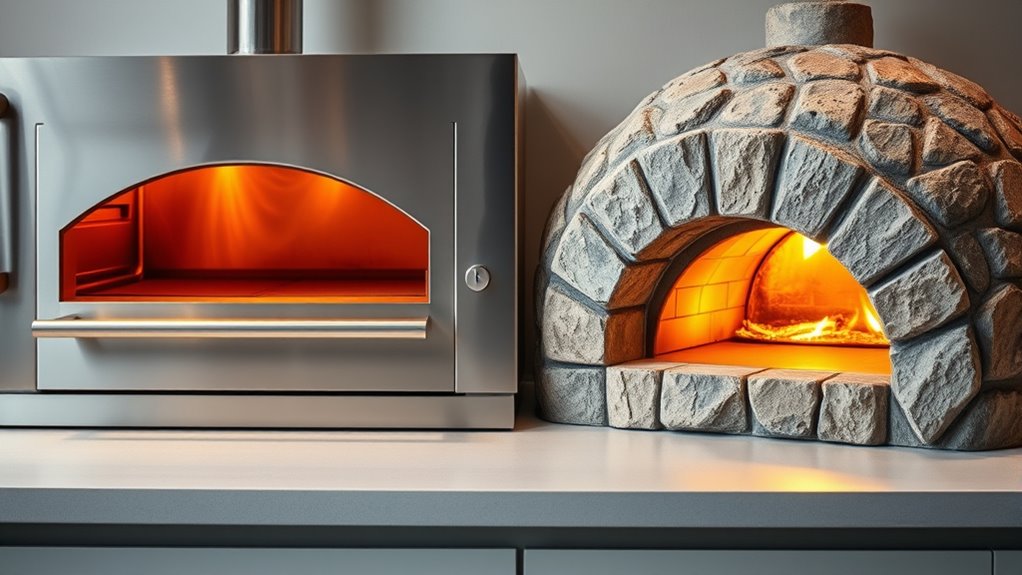
Investing in the right pizza surface can vary widely in cost, impacting your overall budget for setting up a home or professional pizza station. Stone surfaces tend to be more affordable upfront but may require more effort for heat retention. Steel surfaces usually come with a higher initial cost but heat quickly and evenly, potentially saving money over time. Here’s a quick cost comparison:
| Material | Approximate Cost | Durability & Maintenance |
|---|---|---|
| Pizza Stone | $50 – $150 | Moderate; prone to cracking |
| Steel | $150 – $400 | High; resistant to damage |
| Combination | $200 – $500 | Versatile, adaptable |
Use these investment tips to balance your budget with long-term performance, ensuring you choose the best surface for your needs. Additionally, understanding the thermal properties of each material can help you make an informed decision about heat retention and cooking efficiency.
Making the Final Choice: Which Is Best for Your Kitchen and Style?
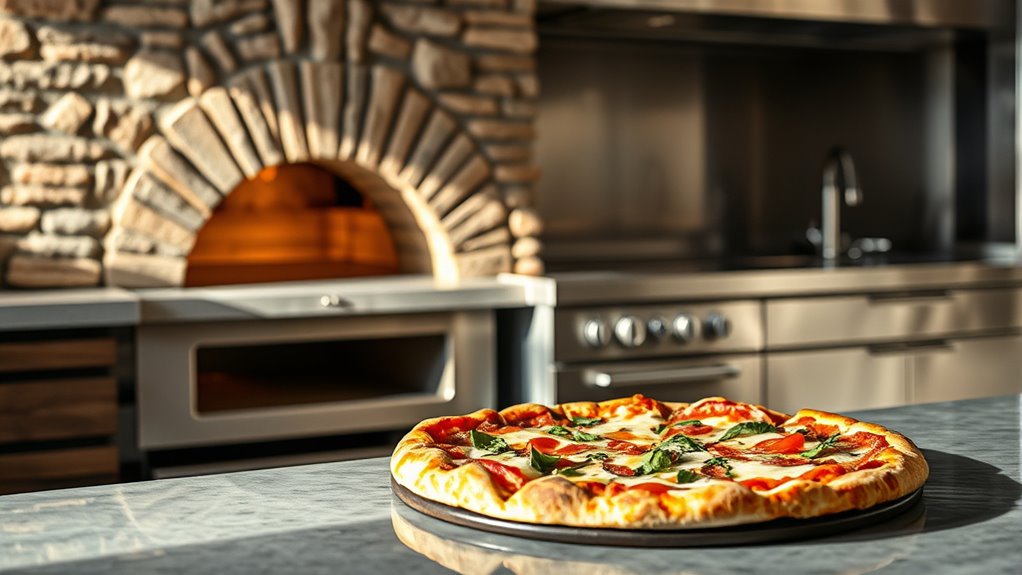
Deciding between a pizza stone and steel ultimately depends on your kitchen space, cooking style, and personal preferences. Both options influence your pizza crust’s texture and your oven compatibility. To help make your choice, consider these factors:
- Oven Size & Compatibility – Steel heats up faster and can handle higher temperatures, but requires a sturdy oven.
- Cooking Speed & Results – Steel delivers quicker, crisper crusts; stone provides more even baking but takes longer.
- Ease of Use & Maintenance – Steel is lighter and easier to handle; stone needs careful cleaning to prevent cracking.
- Long-Term Investment – Steel often lasts longer, offering better value over time for consistent pizza results.
Additionally, heat retention plays a crucial role in how well each material maintains high temperatures for optimal baking.
Choose based on your available space, desired crust style, and how much time you want to invest in prep and maintenance.
Frequently Asked Questions
Can Stones or Steels Be Used on Induction Cooktops?
Stones and steels can be used on induction cooktops if they’re induction compatible, meaning they have a ferromagnetic base. Steel, especially cast iron or stainless steel, typically works well because of excellent heat distribution and induction compatibility. Stones, like pizza stones, usually aren’t induction compatible unless made with a magnetic material. Always check your cookware’s bottom for the induction symbol to verify safe, effective heat distribution.
How Do Stones and Steels Affect Oven Temperature Stability?
Imagine a warm embrace that gently holds heat; stones and steels do just that. They enhance oven temperature stability by improving thermal transfer and heat retention, creating a more consistent heat environment. As they soak up and slowly release heat, they help maintain steady oven temps, reducing fluctuations. This results in better pizza crusts and more reliable baking, giving you a professional touch with every pie.
Are There Health Concerns With Using Stones or Steels?
There are generally no significant health safety concerns with using stones or steels for pizza, as long as you choose food-grade, non-toxic materials. Most stones and steels are made from safe materials like cordierite or steel, which aren’t toxic. Just guarantee proper cleaning and avoid using any treated or glazed options that might contain harmful substances. Regular maintenance helps keep your cooking safe and your pizza delicious.
Can Stones or Steels Be Customized or Engraved?
Yes, you can customize or engrave stones or steels. Many manufacturers offer engraving options for personalization, making your pizza setup unique. When exploring customization tips, consider selecting a design or message that reflects your style or brand. Keep in mind that stones are more delicate, so choose engravings that won’t crack or chip easily. Steel surfaces are more durable for intricate engravings, ensuring your design lasts through many pizza nights.
What Are the Best Storage Practices for Stones and Steels?
Imagine your stones and steels as culinary royalty needing a throne—preferably dry and dust-free. Store them in a cool, dry place, avoiding humidity that could turn them into pizza swamp monsters. Use storage tips like keeping them upright or hanging to prevent warping. For cleaning methods, wipe with a damp cloth after use and make certain they’re completely dry before storing. This keeps your tools ready for their next fiery adventure!
Conclusion
Ultimately, choosing between a stone and steel comes down to your cooking style and preferences. Both can help you craft delicious, crispy pizzas — but remember, “you get what you pay for.” If you value speed and durability, steel might be your best bet. If you prefer a traditional, hands-on approach, a stone could be perfect. Whichever you choose, with a little practice, you’ll be making pizza like a pro in no time.


